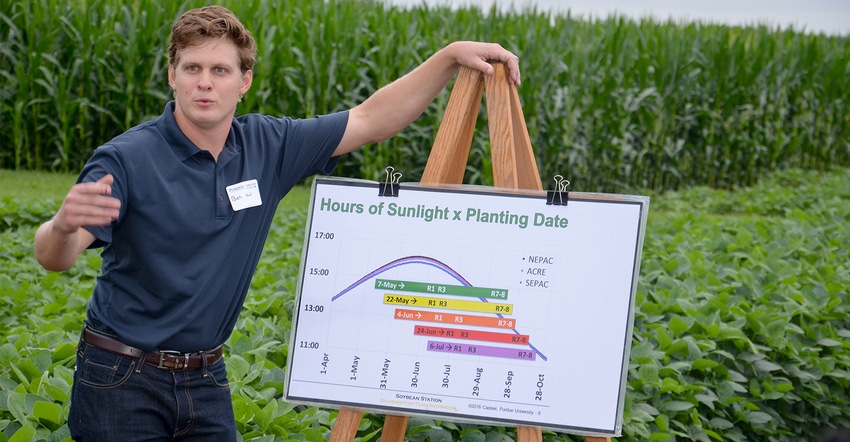
Soybean yield decreases, on average, as planting date slips into late May and June. That’s now considered fact and isn’t news. What is news, however, is that specific quality traits, including the makeup of oil content, also change from early to later planting dates. Oleic acid content decreases in later-planted soybeans.
“High-oleic acid soybeans are one of the quality traits getting more attention recently,” explains Ben Hall, an assistant working on research with Shaun Casteel, Purdue University Extension soybean specialist. Higher-than-normal oleic acid content of the oil is the driving factor behind DuPont Pioneer’s Plenish soybeans and Monsanto’s Vistive Gold soybeans.
The oleic acid content varies from around 25% of the oil in conventional soybeans to as much as 75% to 80% in high-oleic varieties, Hall says.
Oil from high-oleic acid soybeans doesn’t need to be hydrogenated. That makes products made from high-oleic soybeans healthier and more attractive in some markets.
Oleic content varies
“What we’ve discovered is that various factors related to soybean production can affect oleic acid content,” Hall continues. “One of the primary factors we’ve identified so far is planting date. Soybeans that are planted earlier have higher oleic acid content.”
Casteel has reported this finding before. Hall’s recent report indicates that they continue to find this tie between planting date and oleic acid content in their trials. His report also discusses what might cause the change.
Their trials so far feature planting dates from April 22 through June. “We don’t have a problem at looking at even earlier planting dates,” Hall says. “It just hasn’t worked out that we could plant earlier than April 22 so far.”
Along with yield oil profile is a key factor for determining if growers can turn a profit growing specialty soybeans such as varieties with the high-oleic trait, Hall says. These soybeans are typically grown under contract. Most contracts specify that oleic acid content must be a minimum of 70% of the oil. If the percentage falls below 70%, there are consequences, depending upon the contract.
“What we’ve seen so far is that planting date is a major factor that affects oleic-acid content,” Hall continues. “As planting date moves into late May and June, high-oleic content typically decreases. Late-planted soybeans can run as low as 65%, which doesn’t make the contract minimum.”
Why the decrease?
Part of their work recently has zeroed in on determining why the high-oleic content tends to decrease with later planting, Hall says. “There seems to be a connection between the amount of sunlight received at key reproduction times for the plant and high-oleic content,” he explains.
“As less sunlight is utilized by the plants during reproduction, oleic acid content drops in these high-oleic varieties. When soybeans reach the R2 to R4 stage in development earlier in the season, more sunlight is available and temperatures are higher. That favors higher oleic acid content in the oil.”
There are still unanswered questions about the tie between environment and content of the oil for this quality trait, Hall notes. They will be looking more closely at weather data in the future.
About the Author(s)
You May Also Like




